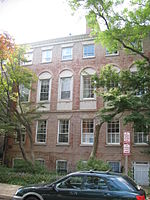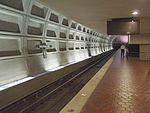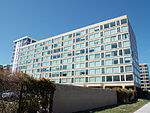Titanic Memorial (Washington, D.C.)

The Titanic Memorial is a granite statue in southwest Washington, D.C., that honors the men who gave their lives so that women and children might be saved during the RMS Titanic disaster. The thirteen-foot-tall figure is of a partly clad male figure with arms outstretched standing on a square base. The base is flanked by a square exedra, created by Henry Bacon, that encloses a small raised platform. The statue was erected by the Women's Titanic Memorial Association. The memorial sits at Fourth and P streets, SW, in Washington Channel Park next to the Washington Channel and Fort Lesley J. McNair. It was designed by Gertrude Vanderbilt Whitney, who won the commission in open competition, and sculpted by John Horrigan from a single piece of red granite furnished from Westerly, Rhode Island, by the Henry C. Smalley Granite Co. It was unveiled May 26, 1931, by Helen Herron Taft, the widow of President Taft. Originally located at the foot of New Hampshire Avenue, NW in Rock Creek Park along the Potomac River, the monument was removed in 1966 and placed into temporary storage to accommodate the Kennedy Center. The memorial was re-erected without ceremony in 1968 at its current location.The French government purchased a replica of the head of the memorial, carved in marble, which it exhibited in Paris in 1921. Currently, this replica is housed in the Musée du Luxembourg.
Excerpt from the Wikipedia article Titanic Memorial (Washington, D.C.) (License: CC BY-SA 3.0, Authors, Images).Titanic Memorial (Washington, D.C.)
O Street Southwest, Washington
Geographical coordinates (GPS) Address External links Nearby Places Show on map
Geographical coordinates (GPS)
| Latitude | Longitude |
|---|---|
| N 38.871944444444 ° | E -77.019305555556 ° |
Address
Titanic Monument
O Street Southwest
20024 Washington
District of Columbia, United States
Open on Google Maps









